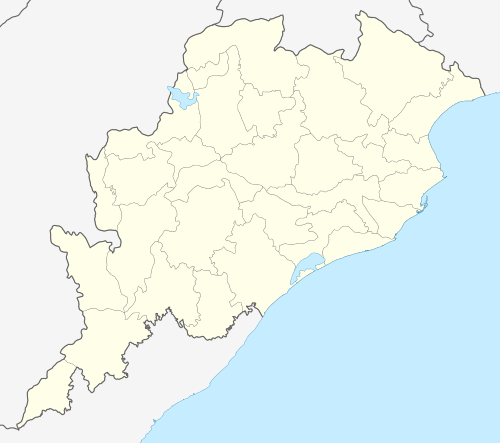Baladevjew Temple
| Baladevjew Temple | |
|---|---|
|
| |
 Baladevjew Temple Location within Odisha  Baladevjew Temple Location within Odisha | |
| Geography | |
| Coordinates | 20°02′N 86°02′E / 20.033°N 86.033°E |
| Country | India |
| State | Odisha |
| District | Kendrapara |
| Location | Ichhapur |
| Culture | |
| Primary deity | Baladevjew |
| Architecture | |
| Number of temples | 1 |
Baladev Jew Temple is situated in Ichhapur (Tulasi Khetra), Kendrapara, Odisha. Baladevjew Temple is a very famous temple of Odisha and Balarama is its main divinity. However, Jagannath and Subhadra are also worshipped in the Ratna Sinhasan in the main temple. An idol representing tulasi as a goddess in a seated position is also present after the sacred seven steps.[1]
History
The present shrine of Siddha Baladeva Jew was constructed during the Maratha rule in Orissa (1761 AD) of Ichhapur (Kendrapara). It was constructed by the king of Kujanga, Raja Gopal Sandha and Zamidar (land lord) of Chhedara killah, Srinivas Narendra Mahapatra. One saint (Santha) Gopi Das and Sairatak Giri convinced the then Maratha Chief Janoji and constructed the Jagamohan, Bhoga Mandapa of the main temple, temple of Gundicha and compound wall.
It is believed that Khan-I-Duran, the subedar of Odisha during the Moghul Emperor Aurangeb demolished the temple in 1661 and built a mosque on the remains of the temple. Devotees of Lord Baladev Jeu, took the deity in disguise in a boat through the river Govari and kept the deity in a secret place near Baranga (Chhedara) Jungle. Afterwards it was shifted to Balarampur village near Luna river at Sakhi Bata. Later it was transferred to the present day Icchapur temple.
Architecture and Construction of Baladev Jew Temple
Baladevjew Temple is constructed over an area of 2 acres (0.81 ha) of land. There are 2 parts in the total area. In one part, different temples are there and the other part is a beautiful garden. There is a boundary around the temple, 46 feet (14 m) high.
There are four main parts of Baladev Jew Temple are
- Bada Deula or Sri Mandir
- Majhi Mandir or Bhog Mandap
- Jagamohan or Natya Mandir
- Bata Mandir or Mukhashala
The main temple is 75 feet (23 m) high and 40 feet (12 m) wide. The main temple has a 7 step construction and heavy baulamalia stone[lower-alpha 1] are used in this construction. There are other small temples inside the premise, where other Gods and Goddesses are worshipped. All the temples have beautiful architecture and are constructed in traditional way.
The other important parts of the temple are Garuda Stambha, Ratna Bhandar, Snana Mandap, Mukti Mandap, Jhulan Gruha, Laxmi Mandira, Anand Bazar, Bhairabi Mandir, NabaGraha Mandir, Kasi Biswonath, Astasambhu Mahadev, Sri Ram mandir, Sidheswar Mahadev, Mukti Mandap, Ganesh mandir, & adhistati Devi Tulasi Temple & about more to click http://baladevjew.webs.com/about-temple
Rituals Followed in Baladev Jew Temple
The deities of Lord Baladevjew, Lord Jagannath and Goddess Subhadra wear different costumes and are decorated in different ways during different important festivals. This tradition is known as Besha (alankara). The Rath Yatra here is famous for the Brahma Taladhwaja Rath.[3]
Some Important Alankara are -
- Sri Raghunatha Besha on Chaitra Purnima Festival.
- Padma Besha on Kartik Purnima Festival and Tulsi Vivah in Kartik.
- Gamhabhisheka Besha – From Shraavana Sukla Dashami to Purnima,holy srinakshatra ceremony of Lord Balarama
- Pushyabhisheka Besha on Pausha Purnima festival
- Kanchi Kaveri Besha on Vasant Panchami festival.
- Suna Besha (Bali Vamana Besha) on Bhadrapad Dwadashi Day
- Krishna Balarama Besha on Phalguna Purnima festival
- Dwibinda banara besha that was offered by Pandit Binod Behari Dash who was a famous Sanskrit scholar of Ichhapur, Kendrapada
& about more to click http://baladevjew.webs.com/about-costum-besha
Offerings
There are arrangements for 3 main Naivedya offerings (Dhupa) and 3 minor offerings (Abakasha) for the deities daily.
- Morning offering (Sakala Dhupa)
- Offering at pre-noon (Madhhyanna Dhupa)
- Rice offering ( Dwiprahara Dhupa/ Anna Dhupa)
- Offering at evening ( Sandhya Aarati Dhupa)
- Rice offering ( Nisankhudi Dhupa)
- Offering at night ( Badasinghar Dhupa)
Different types of offerings (Prasad) are made with trained traditional families, called as Supakara and Mekap are engaged solely for deities. Some of the delicacies are highly patronized in different historic regimes. A comprehensive list of the delicacies is given below.[3]
Baula Gaintha, Upana Pitha, Mithei, Chaurashi Vyanjana(84 vegetable Curry), Makara Chaula, Bhaja,Ghia Anna, Dali, Phalamula (fruits), Dry sweets, Ghanavarta, Pura Kakara, Rasabali, Putuli Pitha, Chipa Kakara, Karanji, Khaja, Magaja Ladoo, Dalimba, Khuduma, Nishkudi, Mutha Gaja, Tala, Chhena Chakata are the famous ones. & about more to click http://baladevjew.webs.com/types-of-prasad
Notes
References
- ↑ Madhusmita. "Baladev Jew Temple Kendrapara". Orissa Spider. Retrieved 21 September 2011.
- ↑ Dr Prafulla Chandra Mohanty (January 2010). "Handicrafts: The Visible Cultural Symbol of Ganjam District" (PDF). Orissa Review. Retrieved 7 March 2013.
- 1 2 Tulasi kshetra – About Sri Sri Baladev Jew Temple, Kendrapara
External links
- http://www.baladevjew.webs.com
- http://www.baladevjew.tk
- report on Baldeva temple
- panorama of sculptures in Baladeva temple,Ichhapur
- History of destruction
